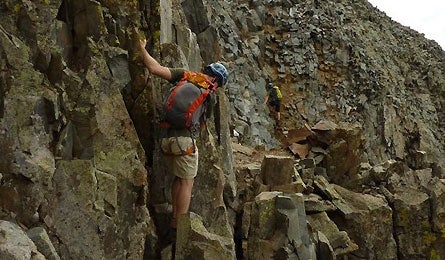Prof. Hike: Making the Best of a Bad Situation

'The author on Colorado's 14,017-foot Wilson Peak (Photo by Will Rietveld)'
A soaking rain almost ruined my first backpacking trip as a kid. Almost. Because as soon as the deluge began, my father covered our packs with giant orange plastic trash bags, transforming my family into a billowing parade of candy-colored—but dry—hikers. “Remember the trash bag trip?” is how we recall this soggy but special weekend. My point isn’t that my family is weird (that’s a given), but that unlucky events—like a drenching downpour—can create better camping memories than a weekend of perfect but boring weather. Since Murphy’s Law is always in effect on the trail, here’s how to adapt to four adverse circumstances.
1. Don’t stop believing
Hitting the wall—when you can’t hike another step—makes you wonder why you left the couch. This fatigue has two sources: physical and mental. Prevent the physical exhaustion by fueling your muscles every 15 to 30 minutes with infusions of trail mix, energy bars, and water. Sugary snacks like dried fruit and candy will give you a quick energy rush, but watch out for the inevitable crash.
Other techniques to maintain your momentum include engaging in conversation, taking frequent, shorter breaks rather than fewer, longer ones, and resting at the top of a hill rather than at the bottom. The mental aspect of fatigue sometimes seems physical, but it’s not. I learned that lesson this summer while climbing Wilson Peak in Colorado’s San Juan Mountains. Exhausted by the time I reached the summit pyramid, I eyed the remaining 100 feet of rocky scrambling and told the guide I couldn’t make it. “Why don’t you sit down for a second, put on a layer, drink some water, and we’ll see,” he told me. Sure enough, after five minutes of rest, I felt much better and summitted the peak with a smile on my face. Recognizing that my physical exhaustion wasn’t real, the guide persuaded my confidence to catch up to my legs.
2. Raindrops keep falling on my head
Since the only surefire way to avoid rain is to stay home (which Prof. Hike grades as an “F”), getting drenched is only a matter of time. In your gear closet should be four items that will boost your spirits (and your warmth) on a rainy day: A broad-brimmed hat, waterproof boots, a waterproof jacket, and a plastic pack cover (or a garbage bag).
Considering rain pants? In my experience, hiking in rain pants (even the breathable kind) in any temperature above 60°F—and during any storm less than torrential—quickly soaks my legs with sweat. So for three-season hiking in light- and medium-rains, I prefer quick-drying nylon pants and shorts. However, if you hike in the chilly, wet Northwest, you might invest in rain pants, as well as low gaiters (ankle-height) to cover your socks and boots. Other rainy-day saviors include simple freeze-dried dinners, highly absorbent microfiber pack towels, and a reliable firestarter like wax-covered dryer-lint stuffed in an old pill bottle.
3. Blister in the sun
The only 100 percent reliable method to prevent a hot spot from becoming a blister—stop walking—is never practical for hikers. Making protective donuts of moleskin and duct tape might buy you time, but if you have miles to hike, you’re going to develop a blister. Applying bandages, antibiotic cream, and duct tape will save skin and limit infections, but unless you’re packing lidocaine (a topical anesthetic), prepare yourself for pain.
The good news is that blister pain is manageable. Sure, it’s rotten for the first 20 minutes after you start hiking, but it soon subsides to a dull ache. Plus, the more you distract yourself with good conversations, guessing games, and amazing views, the less your feet will hurt. Wrapping the affected skin with duct tape will secure bandages for many miles, and when applied preemptively to notorious trouble spots like heels and toes, it can create a friction-free surface to discourage blister formation.
4. Don’t stand so close to me
You can’t choose family, but what about hiking partners? Camping with someone you detest can transform a weekend getaway into a private hell. Common friction points include hiking too fast or too slow, widely disparate pack weights, overly frequent (or infrequent) rest breaks, and inequitable assigning of campsite chores. Protecting yourself requires screening out bad partners such as lone wolfs, summit seekers, constant complainers, and chore shirkers.
If you’re a beginner, don’t hike with experts unless they promise to travel at your pace and experience level. And if you’re leading a trip, communicate realistic expectations about the trip mileage, elevation gains and losses, and obstacles like exposed scrambling before you assemble at the trailhead. Hiking with your spouse or significant other can be a wonderful experience. But to make sure the honeymoon lasts beyond the first mile, both hikers should bring the proper equipment (especially shoes), agree on the total mileage, and recognize that some moves—like rock-hopping across a stream—might be easy for one person and challenging for the other.
—Jason Stevenson